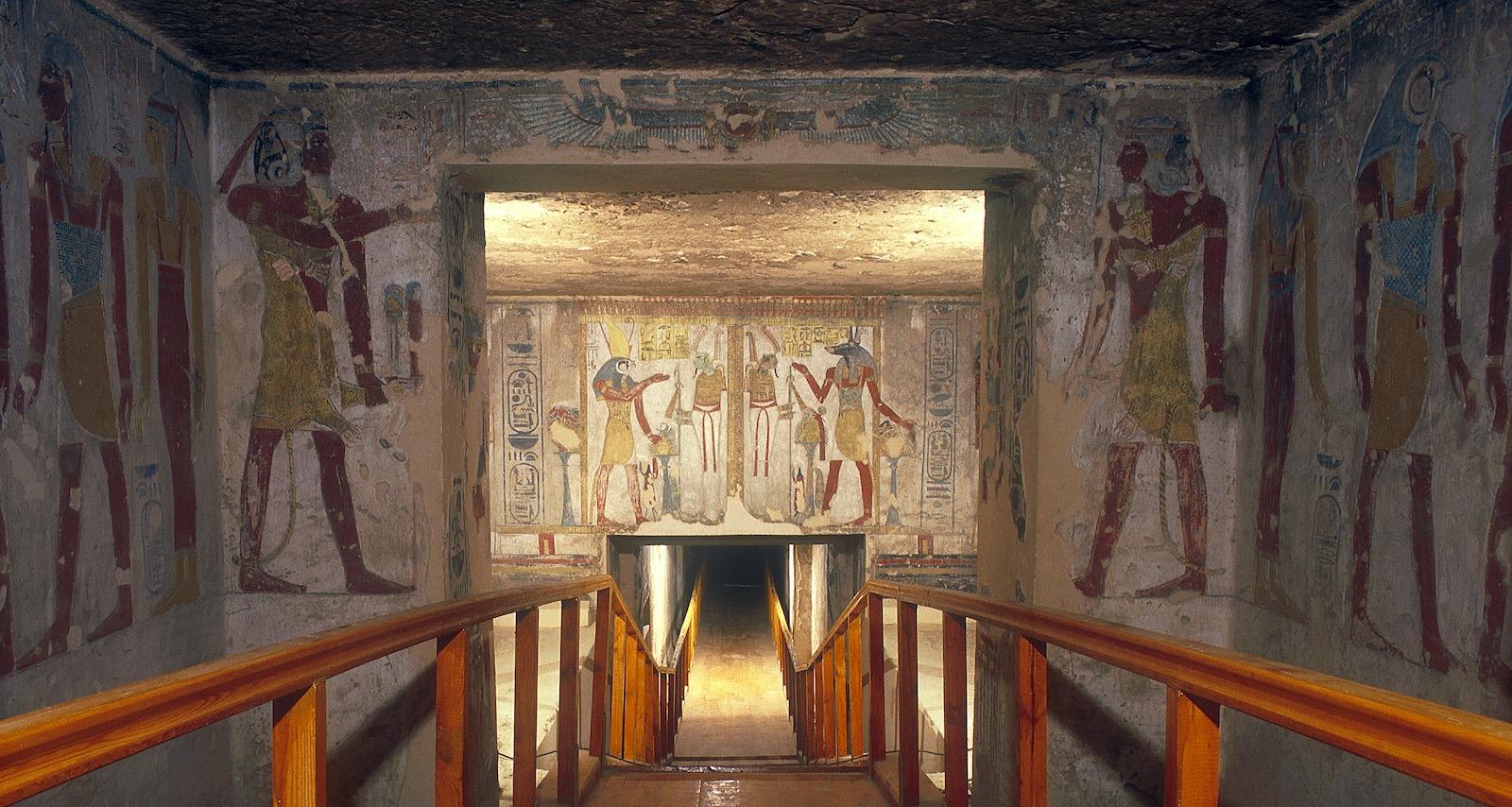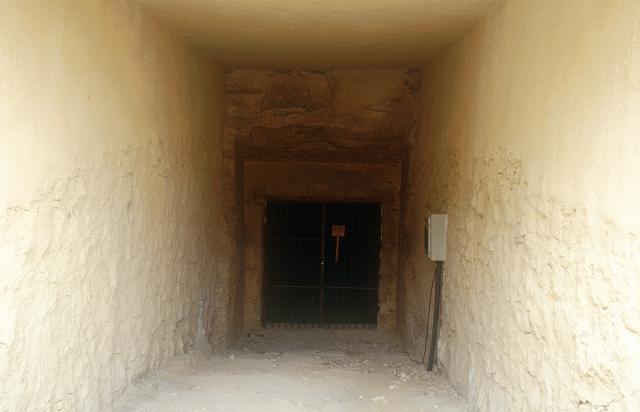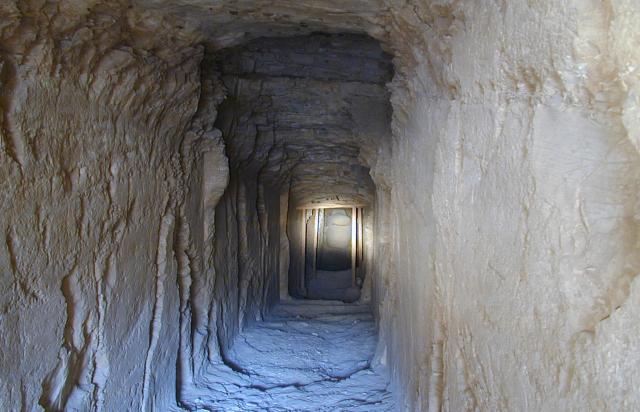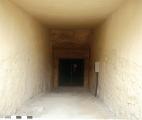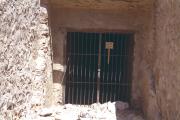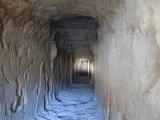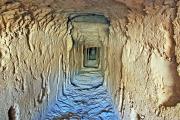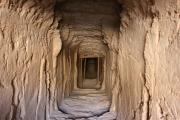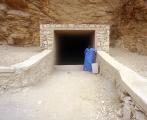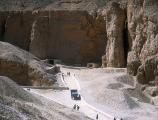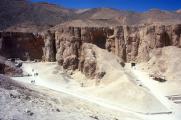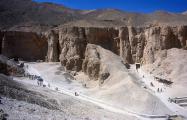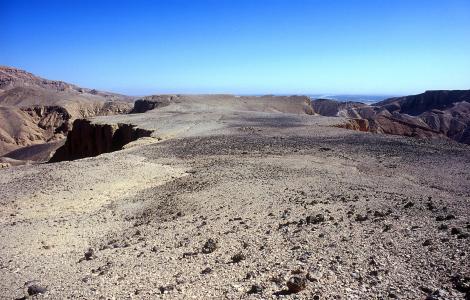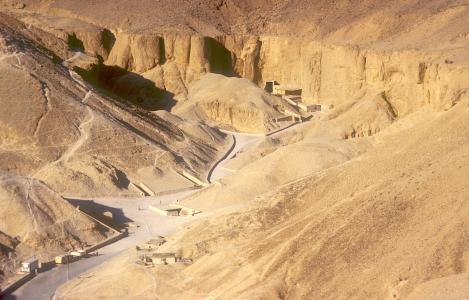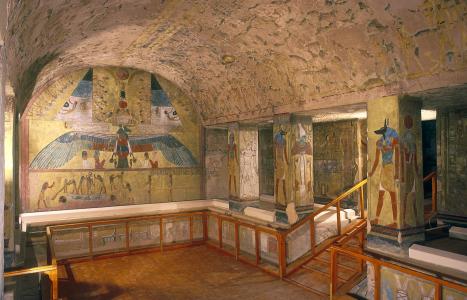KV 13
Bay
Entryway A
See entire tombThe entrance is cut into the base of a cliff, beneath a waterfall, at the head of a branch wadi. The undecorated entrance is open to the sky and a ramp with divided steps leads down to the first gate, beneath a deep overhang. After the 1994 floods, a covered passage was constructed over the entrance.
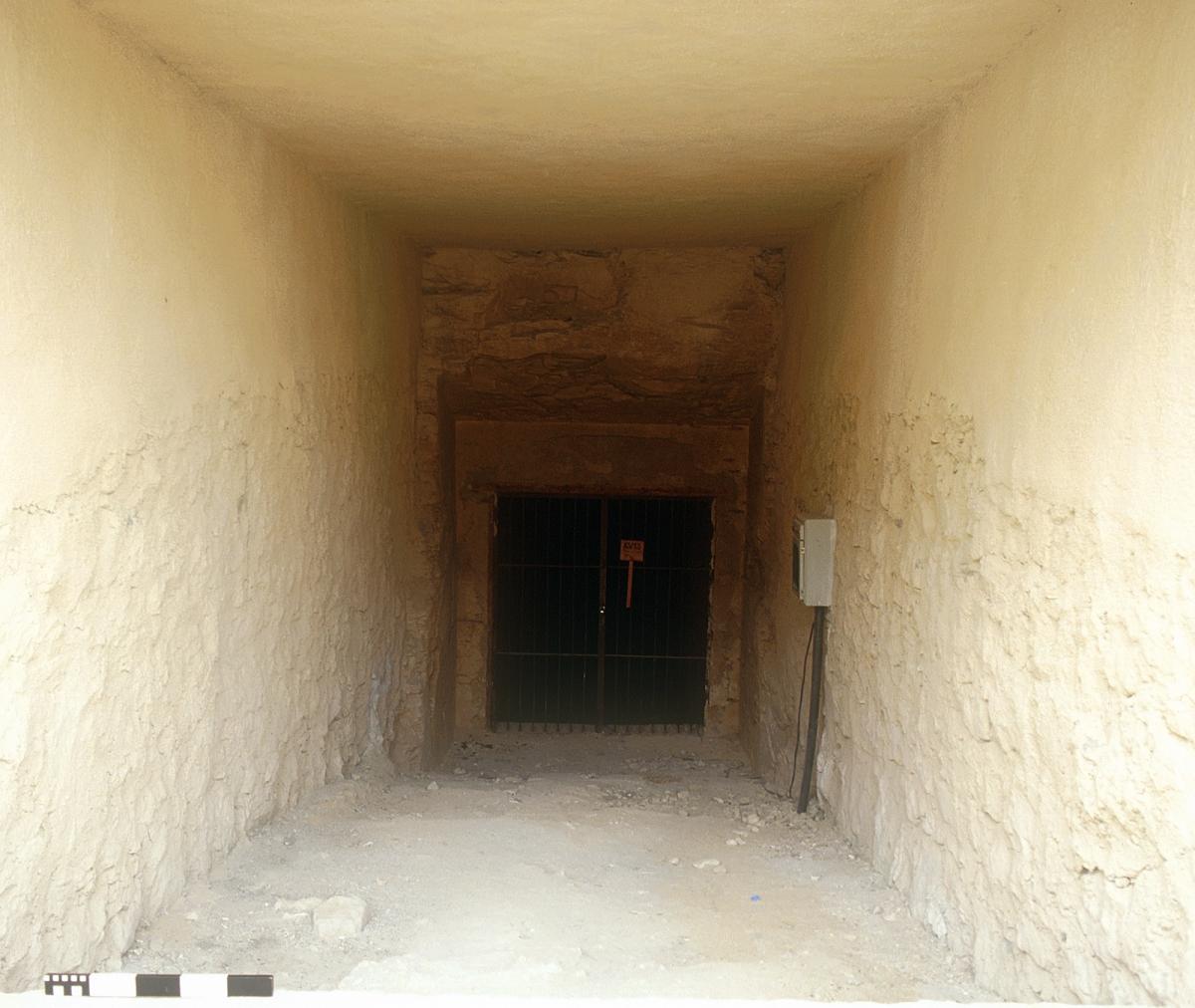
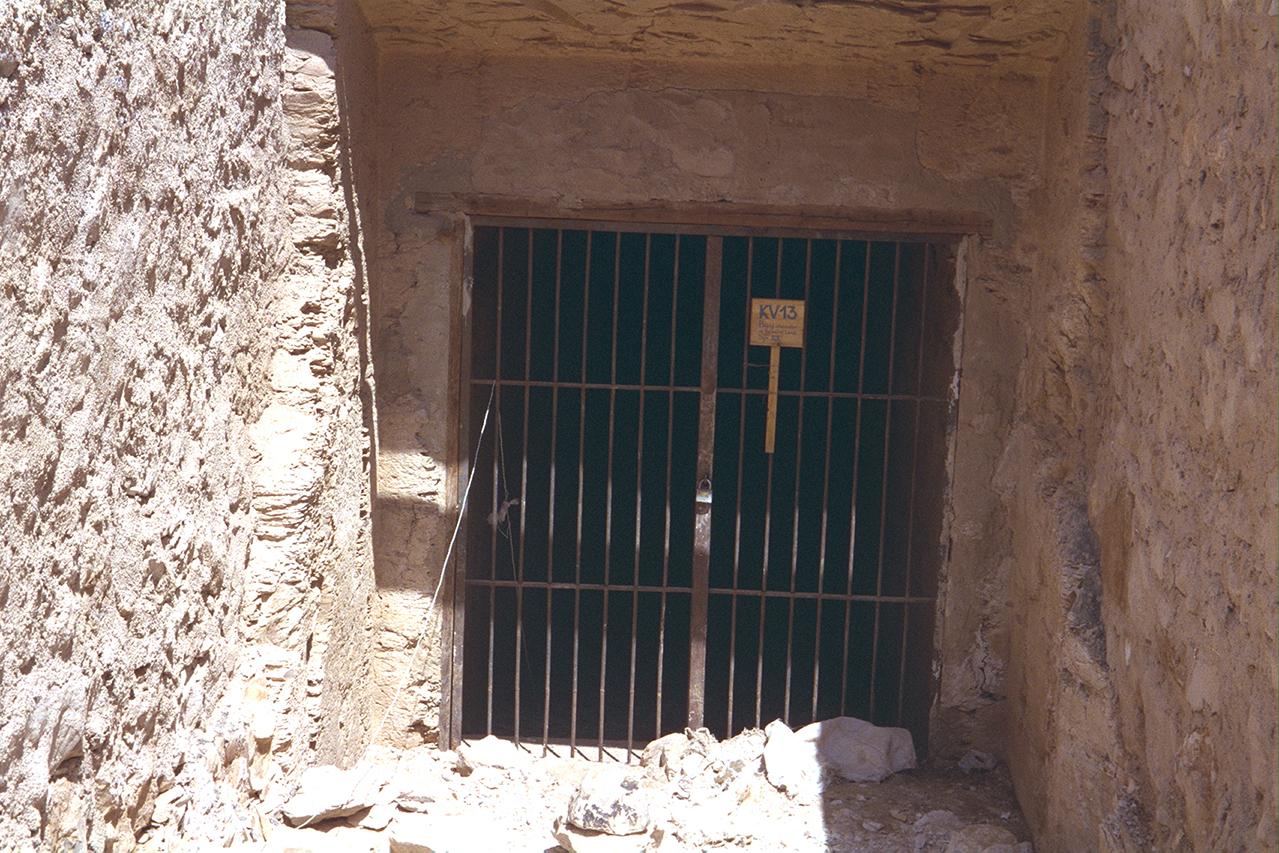
Gate B
See entire tombOn the remains of the outer lintel the sun disc is flanked by figures of Isis and Nephthys, accompanied by the name and titles of the tomb owner. There is a recess in the ceiling inside the gate.
Corridor B
See entire tombThe walls of the first corridor are severely damaged and the ceiling has collapsed. The decorative themes of the corridor, like the tomb of Tausert, show the deceased making offerings before various deities. On the left (south) wall, the first scene shows traces of the winged Ma'at kneeling on a basket over a papyrus cluster. In the next scene, Bay is shown before the falcon-headed sun god Ra. The following scenes are badly preserved, but in one, Bay can be distinguished honoring the king and worshipping various deities. The right (north) wall is in better condition, although the first scene has not survived. One scene shows Bay honoring the king holding a flail. In the next scene, Bay stands before Osiris and a goddess, and in the last he stands before another deity.
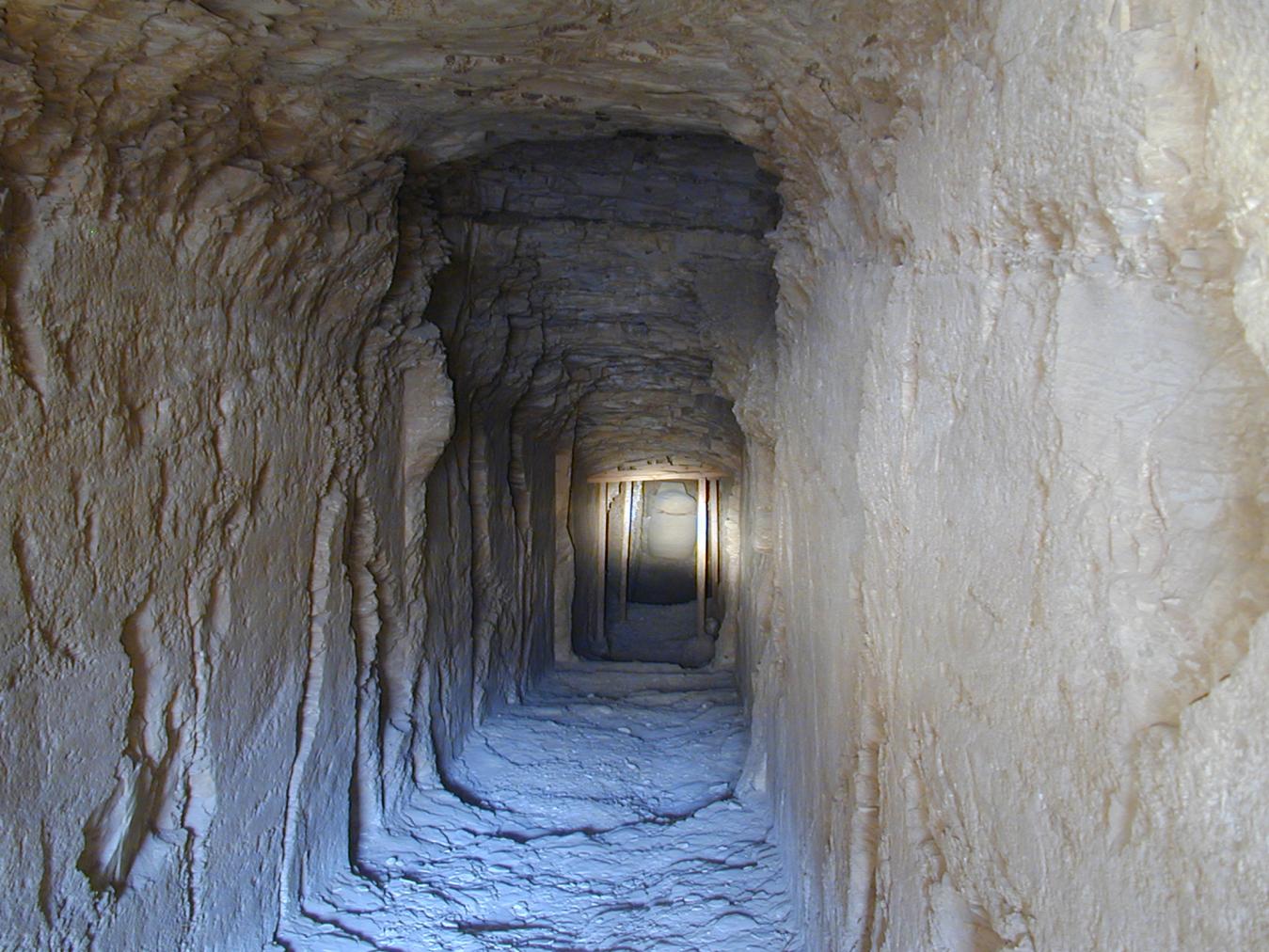
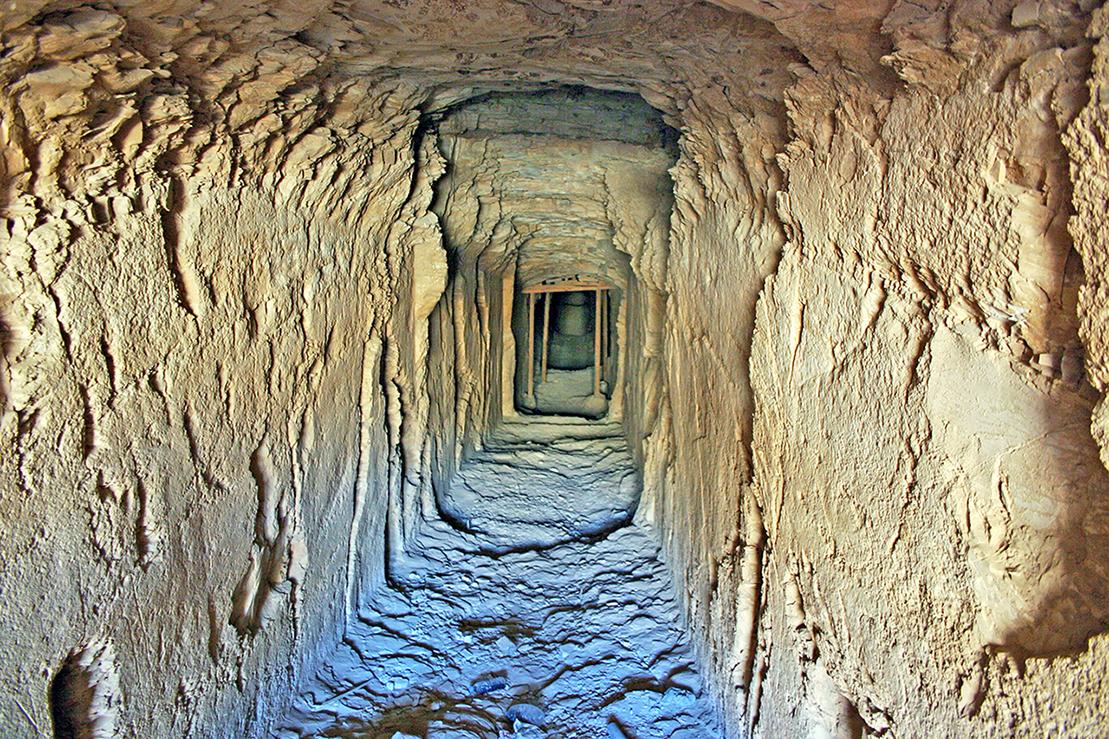
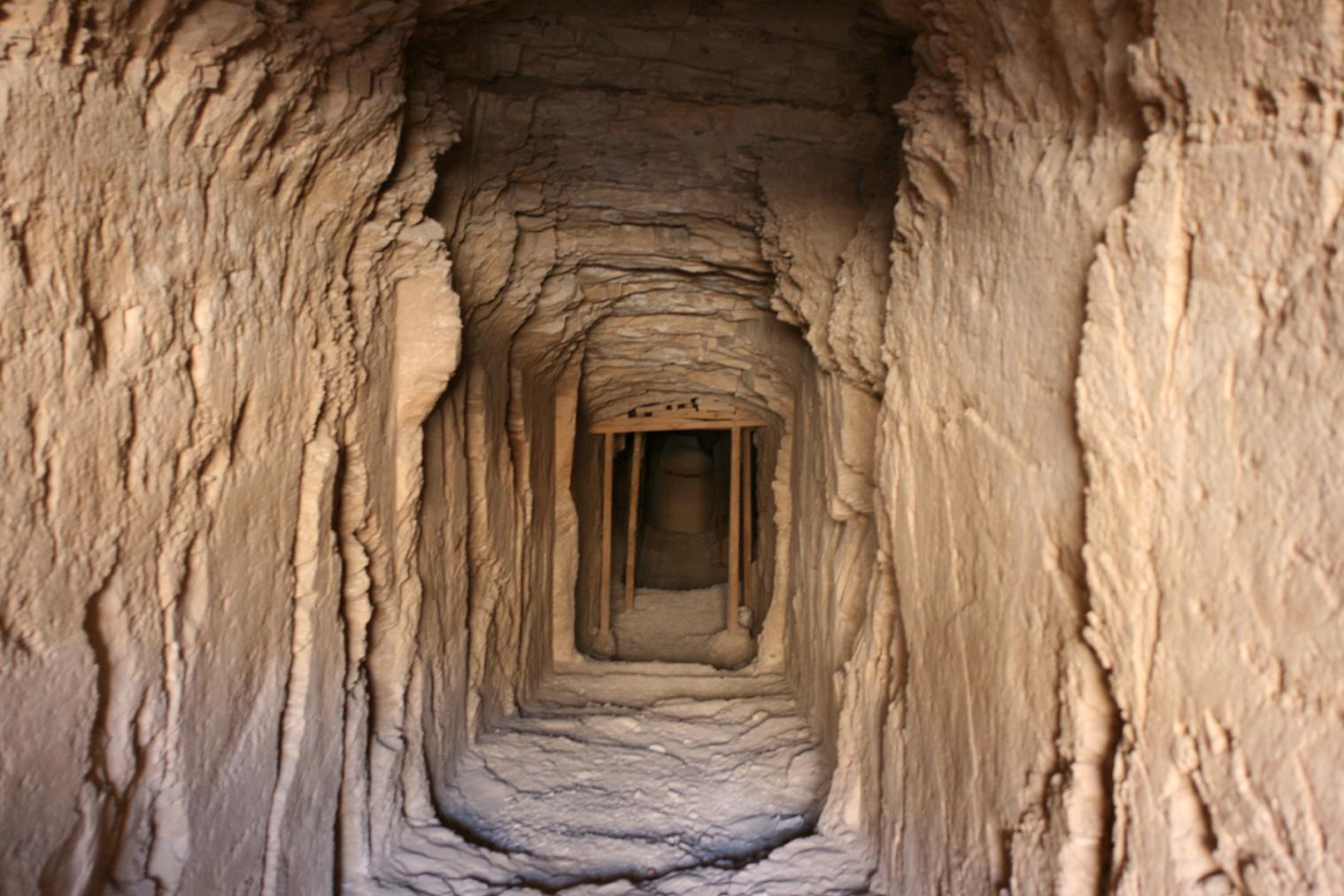
Gate C
See entire tombThere is a step down from the rear of the threshold to the floor of corridor C.
Corridor C
See entire tombThe second corridor has suffered severe flood damage and ceiling has collapsed. A ceiling recess is located at the beginning of the corridor, and a pair of beam holes are located at the end.
The decoration in the second corridor parallels the decoration in the tomb of Tausert. On the left (south) wall are traces of representations of the winged Ma'at, kneeling on a basket over Nile water lilies. This is followed by gates and guardians from the Book of the Dead. At the first gate, Bay stands before the lion-headed guardian. At the third gate, texts from the Book of the Dead are preserved. In the last scene, Bay worships a jackal-headed god who guards the fifth gate. Another representation of the winged Ma'at, badly damaged, decorates the entrance of the right (north) wall. This is followed by the second, fourth and sixth gates from the Book of the Dead, spell 145. The representations of Bay are lost at the fourth and sixth gates, but a guardian with a falcon-head stands at the fourth and a ram-headed guardian deity probably stood at the sixth.
Gate D
See entire tombThere is a step down from the inner edge of the threshold to the floor of corridor D.
Corridor D
See entire tombThe corridor slopes down to chamber E. The walls and ceiling are damaged, but a ceiling recess can be distinguished a the beginning of the corridor. Near the beginning, a few faint marks from reliefs, such as the head of Bay on the right (north) wall, are all that remain of the decoration.
Gate E
See entire tombThe threshold of this gate continues the slope of corridor D into chamber E.
Chamber E
See entire tombThe decoration of chamber E was on plaster, now destroyed, although bits of original plaster have been found on the floor. No well shaft was cut in the floor.
Gate F
See entire tombThe gate joins chamber E to chamber F.
Chamber F
See entire tombThe chamber has suffered severe strucural damage. The decoration, which was executed on plaster, is now lost. Bits of the original plaster have been found on the floor.
Descent F
See entire tombThis sloped descent extends from the beginning of chamber F to gate G.
Gate G
See entire tombThe gate joins descent F to corridor G.
Corridor G
See entire tombThe floor and ceiling of this corridor were flat, although the ceiling has collapsed. No trace of the decoration remains on the walls. It was done on a plaster surface which has fallen away due to flooding. Bits of the original plaster have been found on the floor.
Corridor H
See entire tombThe beginning of the floor in corridor H forms a ramp that slopes downwards to a lower level where a sarcophagus rests. It then rises sharply to the rear.
The red granite mummiform sarcophagus of Prince Mentuherkhepeshef nearly fills the corridor. No decoration remains on the walls, but bits of the original plaster have been found on the floor. The gates to the side chambers are located in the right (north) wall opposite of the sarcophagus.
Gate H
See entire tombThere are no jambs preserved for this gate, but a lintel and a step down from corridor G lead to the ramp in the floor of corridor H.
Gate Ha
See entire tombThe gate leads into side chamber Ha, located to the right (north) of corridor H.
Side chamber Ha
See entire tombA gate in the right (north) wall of corridor H leads to a small, square chamber which is oriented on a south-north axis. The decorated plaster surface has fallen away; a few pieces of which have been found on the floor.
Gate Hb
See entire tombThe gate leads into side chamber Hb, located to the right (north) of corridor H.
Side chamber Hb
See entire tombThe cutting of the side chamber was left unfinished.
Burial chamber J
See entire tombThe burial chamber was roughly quarried and there are no traces of decoration on its walls. At the rear (west) end of the chamber is a recess, perhaps an abandoned cutting for another corridor or enlargement of this chamber. The granite sarcophagus inscribed for Prince Amenherkhepeshef (originally for Queen Tausert) lies in a rectangular depression in the floor at the center of the chamber.
Chamber plan:
RectangularRelationship to main tomb axis:
ParallelChamber layout:
Flat floor, no pillarsFloor:
One levelCeiling:
Flat
Gate J
See entire tombThe gate leads into burial chamber J.
About
About
The tomb of Bay is situated at the end of the southwest branch of the southwest Wadi, close to the tombs of Sety II, Tausert and Siptah. The architecture and decoration closely resemble that of the tomb of Queen Tausert.
It consists of three corridors (B, C, D) followed by two chambers (E, F), two further corridors (G, H), two side chambers off the second (Ha-b), and a burial chamber (J). The tomb has suffered structural damage from floods, and all the ceilings of the tomb have collapsed.
The walls were probably decorated originally with painted plaster and relief. Severe floods have caused the loss of the plaster, however, and now only traces of decoration remain in places where the artist was working on thin plaster and the chiseling cut into the bedrock. The remaining decoration echoes that in KV 14 and represents the deceased with deities (corridor B, corridor D) and parts of the Book of the Dead (corridor C).
Noteworthy features:
This is one of the rare non-royal tombs cut in the Valley during Dynasty 19. The tomb also demonstrates the late Rameside practice of re-using abandoned tombs for the burial of royal family members, containing two sarcophagi from this period.
Site History
The tomb was built for Bay, originally a royal scribe of Sety II and later chancellor under Siptah. The privilege of being granted a tomb in the Valley of the Kings reflects his status. The tomb, however, was left unfinished and was later reused by the royal princes Amenherkhepshef and Mentuherkhepshef in Dynasty 20.
A slight deviation in orientation between corridor G and corridor H led Altenmüller to suggest that originally the tomb was only finished until corridor G, and that corridor H and the burial chamber J were additions in Dynasty 20. The tomb was partly accessible since antiquity, but no late graffiti are recorded.
Dating
This site was used during the following period(s):
Exploration
Conservation
Conservation History
During clearance, plaster was applied to the walls and ceiling in the rear chambers. Following the 1994 floods, a covered passage was built over entryway A.
Site Condition
The tomb is located beneath a cascade from the Valley of the Kings drainage basin above the cliff. This position has made it particularly susceptible to flooding. At least four floods were responsible for the extensive damage to decoration and architecture, and they filled the tomb with debris. As a result, most of the painted plaster sunk relief decoration on the walls has been lost, with traces preserved only when the artist cut into the stone surface beneath the plaster coating.
Hieroglyphs
Bay
 Official Bay
Official Bay
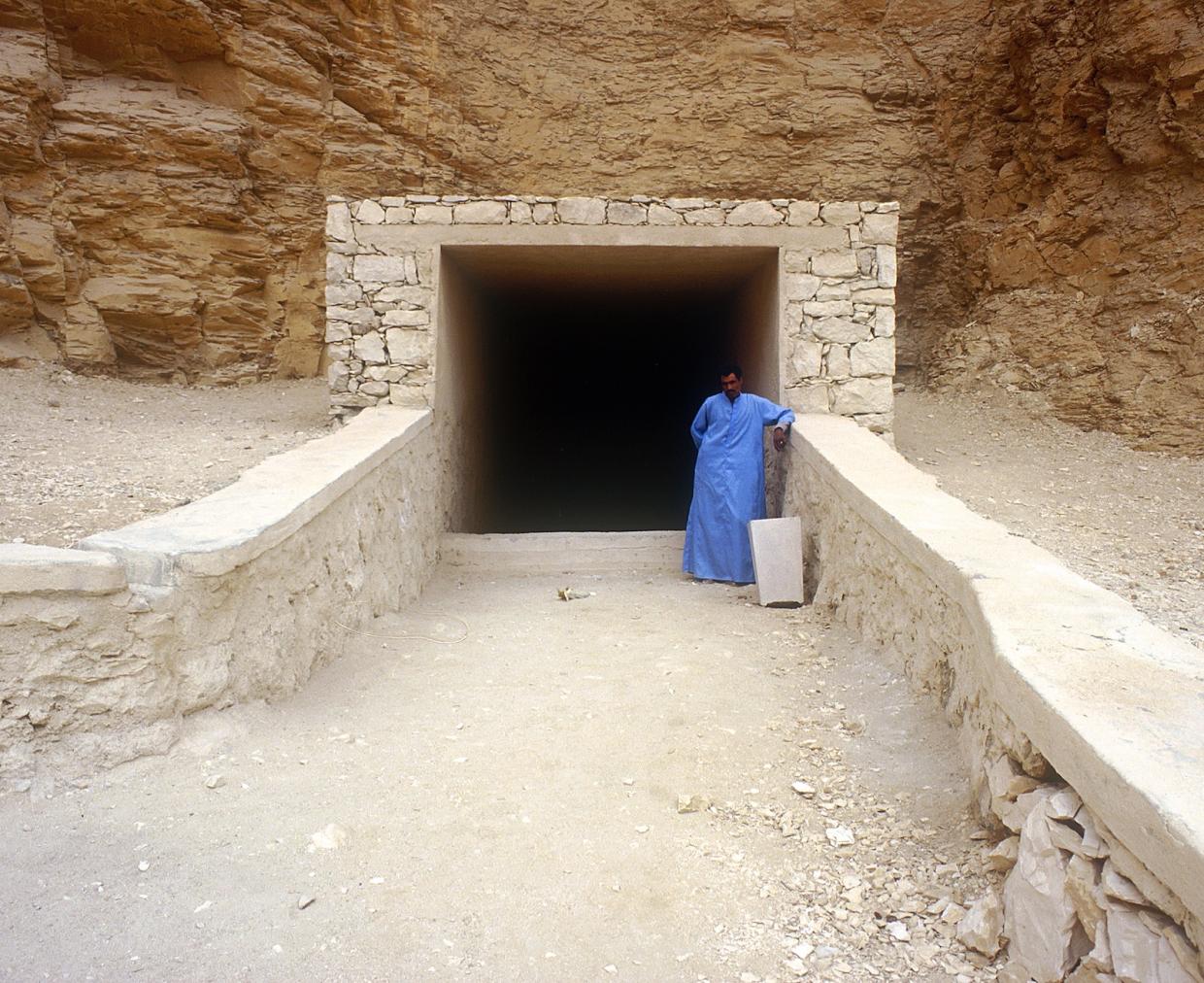
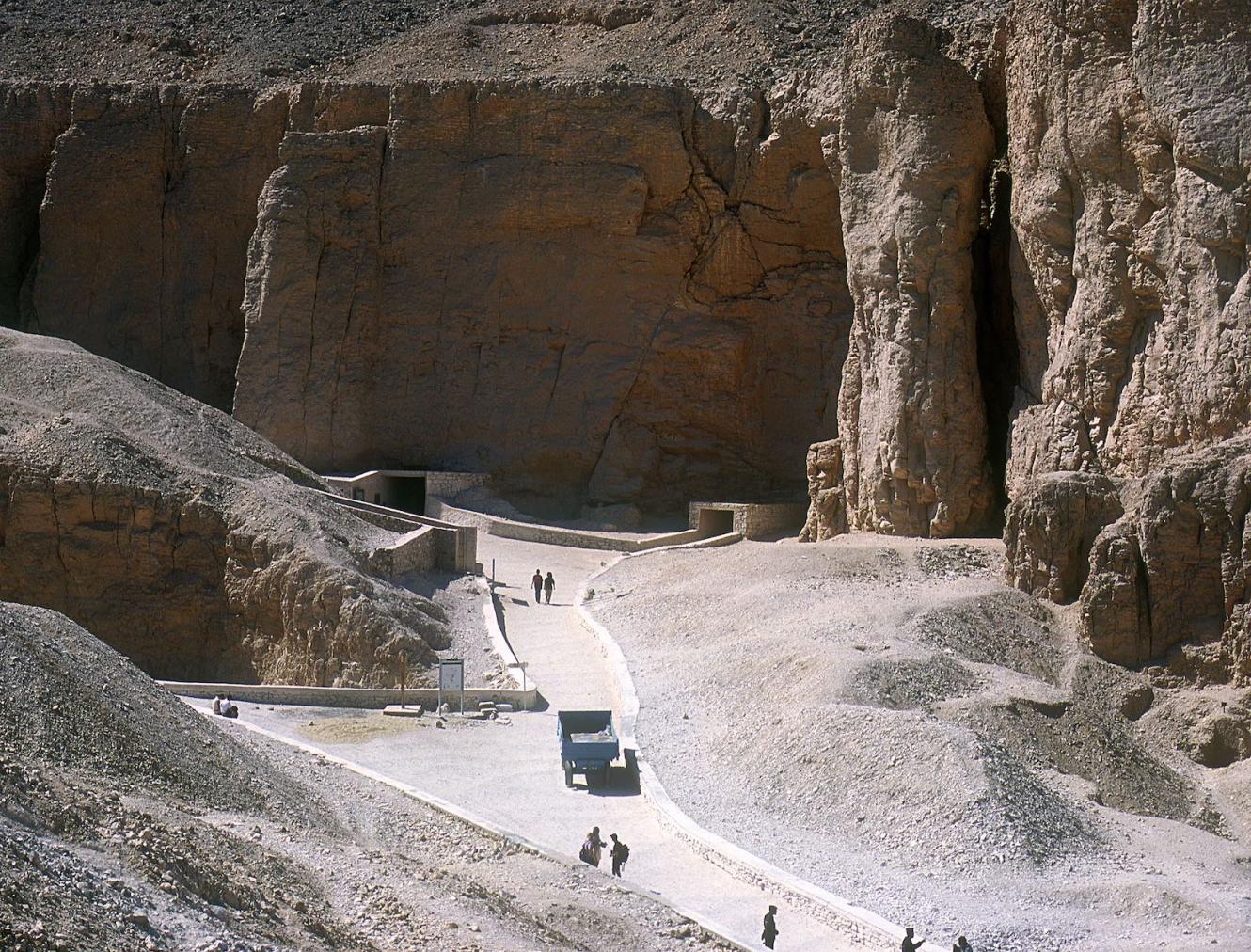
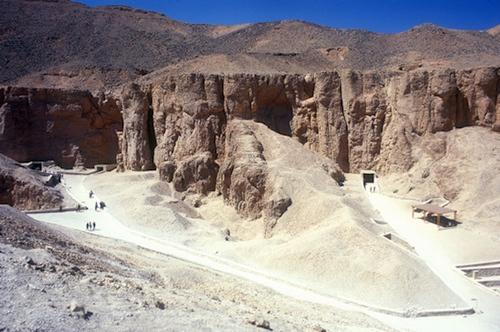

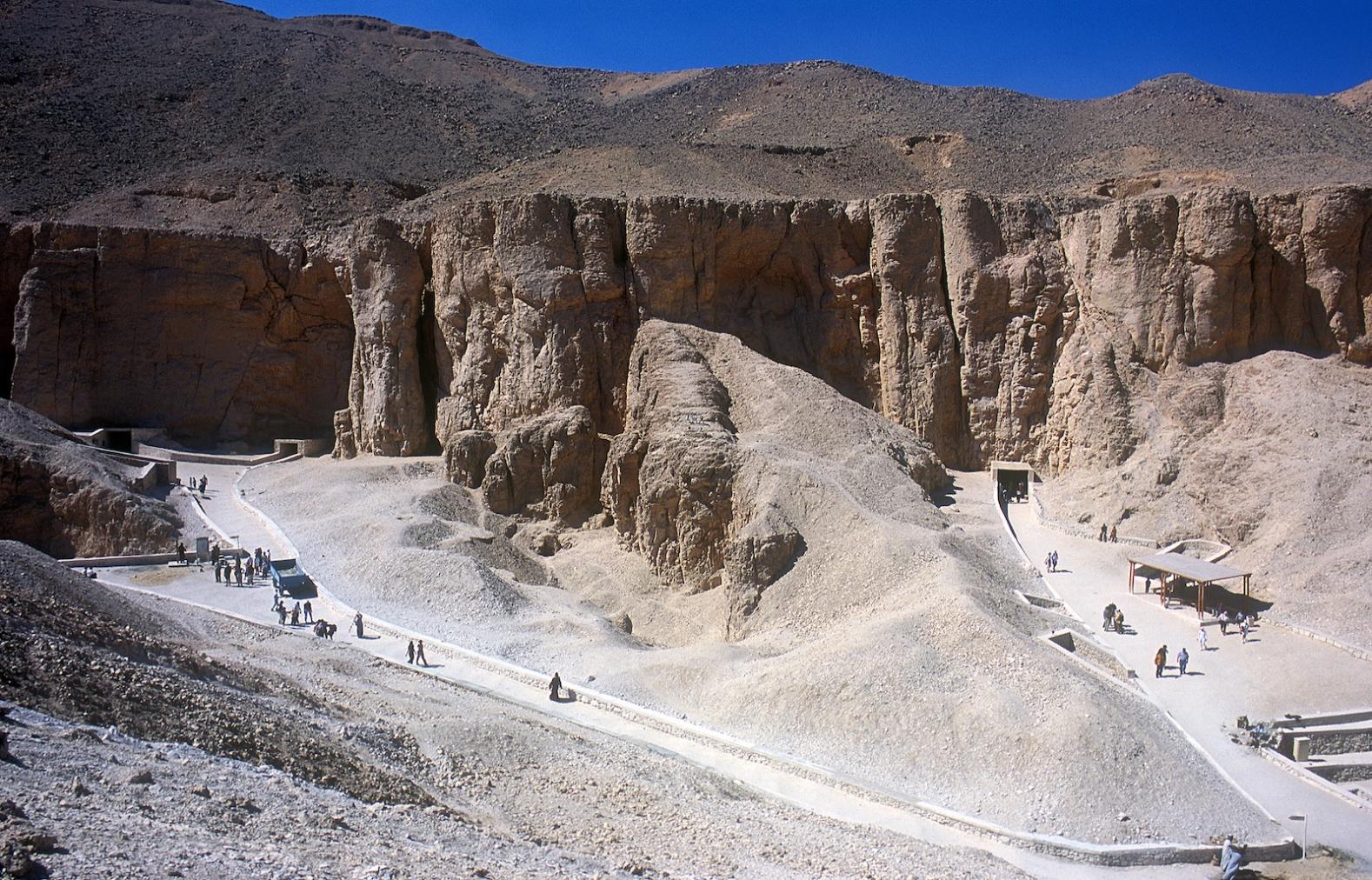




Articles
Geography and Geology of the Valley of the Kings
Historical Development of the Valley of the Kings
Anatomy of a Tomb: Ancient and Modern Designations for Chambers and Features
Bibliography
Altenmüller, Hartwig. Untersuchungen zum Grab des Bai (KV 13) im Tal der Könige von Theben. Göttingen Miszellen 107 (1989): 43-54.
Altenmüller, Hartwig. Dritter Vorbericht über die Arbeiten des Archäologischen Instituts der Universitäts Hamburg am Grab des Bay (KV 13) im Tal der Könige von Theben. Studien zur altägyptischen Kultur 21 (1994): 1-18.
Altenmüller, Hartwig. Prinz Mentu-her-chopeschef aus des 20. Dynastie. Mitteilungen des Deutschen Archäologischen Instituts: Abteilung Kairo, 50 (1994): 1-22.
Altenmüller, Hartwig. Zweiter Vorbericht über die Arbeiten des Archäologischen Instituts der Universitäts Hamburg am Grab des Bay (KV 13) im Tal der Könige von Theben. Studien zur altägyptischen Kultur 19 (1992): 15-36.
Fekri, Magdi Mohammed. Une nouvelle enquête sur les tombes civiles et enonymes de la Vallée des Rois. In: Zahi Hawass, (ed.), Egyptology at the Dawn of the Twenty-First Century: Proceedings of the Eighth International Congress of Egyptologists, Cairo, 2000. Two vols. Cairo: American University in Cairo Press, 1003. Pp. 180-184.
Helck, Wolfgang. Königsgräbertal. Wolfgang Helck, Eberhart Otto and Wolfhart Westendorf (eds.). Lexikon der Ägyptologie. 7 vols. Wiesbaden, 1972-1992. 3: 516.
Lefebure, Eugène. Les hypogées royaux de Thèbes, seconde division: Notices des hypogées (=Mémoires publiés par les members de la mission archéologie française au Caire 3, 1). Paris, 1889. P. 122.
Porter, Bertha and Rosalind Moss. Topographical Bibliography of Ancient Egyptian Hieroglyphic Text, Reliefs, and Paintings. I, 2. The Theban Necropolis: Royal Tombs and Smaller Cemeteries. Oxford: Clarendon Press, 1964. Pp. 527.
